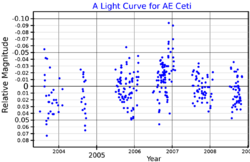Astronomy:7 Ceti
| Observation data Equinox J2000.0]] (ICRS) | |
|---|---|
| Constellation | Cetus |
| Right ascension | 00h 14m 38.41655s[2] |
| Declination | −18° 55′ 58.3145″[2] |
| Apparent magnitude (V) | 4.44[3] (4.26–4.46)[4] |
| Characteristics | |
| Spectral type | M1 III[5] |
| B−V color index | 1.640±0.044[3] |
| Variable type | LB:[4] |
| Astrometry | |
| Radial velocity (Rv) | −22.9±1.0[6] km/s |
| Proper motion (μ) | RA: −26.15[2] mas/yr Dec.: −73.58[2] mas/yr |
| Parallax (π) | 7.29 ± 0.28[2] mas |
| Distance | 450 ± 20 ly (137 ± 5 pc) |
| Absolute magnitude (MV) | –1.24[3] |
| Details | |
| Radius | 54[7] R☉ |
| Luminosity | 1019.14[8] L☉ |
| Temperature | 3,800[8] K |
| Other designations | |
| Database references | |
| SIMBAD | data |
7 Ceti is a single,[10] variable star in the equatorial constellation of Cetus. It has the variable star designation AE Ceti.[1] The star is visible to the naked eye with a baseline apparent visual magnitude of 4.44.[3] Based upon an annual parallax shift of only 7.3 mas,[2] it is located roughly 450 light years away. It is moving closer to the Sun with a heliocentric radial velocity of −23 km/s.[6] Eggen (1965) listed it as a probable member of the Wolf 630 group of co-moving stars.[11]
This is an aging red giant star with a stellar classification of M1 III,[5] currently on the asymptotic giant branch.[12] Samus et al. (2017) has it classed as a slow irregular variable of type LB:, and ranges in magnitude from 4.26 down to 4.46.[4] Tabur et al. (2009) list it as a semiregular variable with four known periods ranging in frequency from 19.2 to 41.7 days.[1] The stellar atmosphere of 7 Ceti has expanded to an estimated 54[7] times the Sun's radius. It is radiating around 1,019[8] times the Sun's luminosity from its enlarged photosphere at an effective temperature of 3,800 K.[8]
| Period (Days) |
Amplitude (Mag.) |
|---|---|
| 19.2 | 0.018 |
| 19.6 | 0.020 |
| 27.1 | 0.018 |
| 41.7 | 0.017 |
References
- ↑ 1.0 1.1 1.2 1.3 Tabur, V. et al. (December 2009), "Long-term photometry and periods for 261 nearby pulsating M giants", Monthly Notices of the Royal Astronomical Society 400 (4): 1945–1961, doi:10.1111/j.1365-2966.2009.15588.x, Bibcode: 2009MNRAS.400.1945T.
- ↑ 2.0 2.1 2.2 2.3 2.4 2.5 van Leeuwen, F. (2007), "Validation of the new Hipparcos reduction", Astronomy and Astrophysics 474 (2): 653–664, doi:10.1051/0004-6361:20078357, Bibcode: 2007A&A...474..653V.
- ↑ 3.0 3.1 3.2 3.3 Anderson, E.; Francis, Ch. (2012), "XHIP: An extended hipparcos compilation", Astronomy Letters 38 (5): 331, doi:10.1134/S1063773712050015, Bibcode: 2012AstL...38..331A.
- ↑ 4.0 4.1 4.2 Samus, N. N. et al. (2017), "General Catalogue of Variable Stars", Astronomy Reports, 5.1 61 (1): 80–88, doi:10.1134/S1063772917010085, Bibcode: 2017ARep...61...80S.
- ↑ 5.0 5.1 Houk, Nancy; Smith-Moore, M. (1978), Michigan catalogue of two-dimensional spectral types for the HD stars, 4, Ann Arbor: Dept. of Astronomy, University of Michigan, Bibcode: 1988mcts.book.....H.
- ↑ 6.0 6.1 de Bruijne, J. H. J.; Eilers, A.-C. (October 2012), "Radial velocities for the HIPPARCOS-Gaia Hundred-Thousand-Proper-Motion project", Astronomy & Astrophysics 546: 14, doi:10.1051/0004-6361/201219219, A61, Bibcode: 2012A&A...546A..61D.
- ↑ 7.0 7.1 Pasinetti Fracassini, L. E. et al. (February 2001), "Catalogue of Apparent Diameters and Absolute Radii of Stars (CADARS)", Astronomy and Astrophysics 367 (2): 521–524, doi:10.1051/0004-6361:20000451, Bibcode: 2001A&A...367..521P.
- ↑ 8.0 8.1 8.2 8.3 McDonald, I. et al. (2012), "Fundamental parameters and infrared excesses of Hipparcos stars", Monthly Notices of the Royal Astronomical Society 427 (1): 343–357, doi:10.1111/j.1365-2966.2012.21873.x, Bibcode: 2012MNRAS.427..343M.
- ↑ "7 Cet". SIMBAD. Centre de données astronomiques de Strasbourg. http://simbad.u-strasbg.fr/simbad/sim-basic?Ident=7+Cet.
- ↑ Eggleton, P. P.; Tokovinin, A. A. (September 2008), "A catalogue of multiplicity among bright stellar systems", Monthly Notices of the Royal Astronomical Society 389 (2): 869–879, doi:10.1111/j.1365-2966.2008.13596.x, Bibcode: 2008MNRAS.389..869E.
- ↑ Eggen, O. J. (October 1965), "The Wolf 630 group", The Observatory 85: 191–195, Bibcode: 1965Obs....85..191E,
- ↑ Eggen, O. J. (1992), "Asymptotic giant branch stars near the sun", The Astronomical Journal 104: 275, doi:10.1086/116239, Bibcode: 1992AJ....104..275E.
 |


